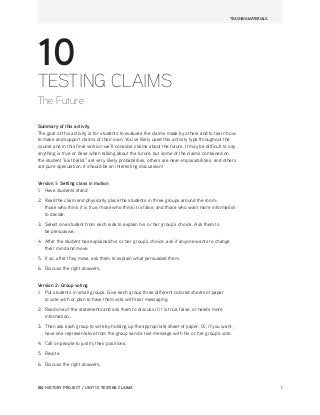
Big History Project Unit 10 Activity Student Claims Testing About the Future
- 1. TEACHING MATERIALS BIG HISTORY PROJECT / UNIT 10 TESTING CLAIMS 1 10 TESTING CLAIMS The Future Summary of this activity The goal of this activity is for students to evaluate the claims made by others and to learn how to make and support claims of their own. You’ve likely used this activity type throughout the course and in this final version we’ll consider claims about the future. It may be difficult to say anything is true or false when talking about the future, but some of the claims contained on the student “exit ballot” are very likely probabilities, others are near-‐impossibilities, and others are pure speculation. It should be an interesting discussion! Version 1: Setting class in motion 1. Have students stand 2. Read the claim and physically place the students in three groups around the room: those who think it is true, those who think it is false, and those who want more information to decide. 3. Select one student from each side to explain his or her group’s choice. Ask them to be persuasive. 4. After the student has explained his or her group’s choice, ask if anyone wants to change their mind and move. 5. If so, after they move, ask them to explain what persuaded them. 6. Discuss the right answers. Version 2: Group voting 1. Put students in small groups. Give each group three different colored sheets of paper to vote with or plan to have them vote with text messaging. 2. Read one of the statements and ask them to discuss if it is true, false, or needs more information. 3. Then ask each group to vote by holding up the appropriate sheet of paper. Or, if you want, have one representative from the group send a text message with his or her group’s vote. 4. Call on people to justify their positions. 5. Revote. 6. Discuss the right answers.
- 2. TEACHING MATERIALS BIG HISTORY PROJECT / UNIT 10 TESTING CLAIMS 2 Answer key The 1st and 4th statements are true. The 2nd is false. The 3rd and 5th need more information. Sample justifications 1. Most scientists and researchers believe that human population will exceed 8 billion in the next 100 years. This article outlines United Nations projections for a global population exceeding 10 million by 2100. http://www.scientificamerican.com/article.cfm?id=human-‐pop-‐ ulation-‐growth-‐creeps-‐back-‐up 2. Scientists estimate that the Sun will become a red giant billions of years in the future. As a low-‐mass, medium-‐size star, our Sun has a very long life cycle and a very long time before it starts into its red giant phase. When it does, it will grow immensely larger and is likely to swallow up the current orbit of Earth. However, its gravitational pull may decrease and the orbits of some of the planets may expand outward. As a medium-‐size star, our Sun will not become a supernova. 3. In the last two centuries, innovation has kept up with population growth enough to prevent a Malthusian cycle of famine, but it is hard to say whether humans will be able to solve a likely food crisis as the population continues to grow. 4. With plate tectonics, the continents are always moving. The landmasses of the Earth have already gone through a number of different configurations, which geologists sometimes refer to as the “continent cycles.” Some geologists expect that “Pangaea Ultima” will form about 250 million years in the future. http://www.scotese.com/ 5. As global connectivity increases and humans continue to innovate, collective learning will continue to accelerate among humans. It’s impossible to say whether we’ll connect with another life form in this unique way. TESTING CLAIMS The Future
- 3. BIG HISTORY PROJECT / UNIT 10 TESTING CLAIMS 1 10 TESTING CLAIMS The Future We often wonder what the future holds. What will happen next, to us, to the biosphere, to our planet? It may be difficult to say anything is true or false when talking about the future, but the correct answer for the statements below will not always be “need more info.” Some of the claims below are likely probabilities that can be consid-‐ ered true, others are likely impossibilities and therefore false, and others truly do “need more info.” Use this “ballot card” to vote on the truth of each statement and to make notes as to why you believe something is true, false, or needs more information to fairly decide. Human population will surpass 8 billion. TRUE FALSE NEED MORE INFO WHY DO YOU THINK THAT? (Which claim testers did you use: authority, evidence, intuition, logic?) Our Sun will become a red giant and envelope the inner rocky planets within 1 million years. TRUE FALSE NEED MORE INFO WHY DO YOU THINK THAT? (Which claim testers did you use: authority, evidence, intuition, logic?) Humans will run out of food. TRUE FALSE NEED MORE INFO WHY DO YOU THINK THAT? (Which claim testers did you use: authority, evidence, intuition, logic?) The continents will look different in 500 million years. TRUE FALSE NEED MORE INFO WHY DO YOU THINK THAT? (Which claim testers did you use: authority, evidence, intuition, logic?) Humans will learn collectively with other species, perhaps some from another planet. TRUE FALSE NEED MORE INFO WHY DO YOU THINK THAT? (Which claim testers did you use: authority, evidence, intuition, logic?)
